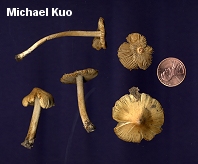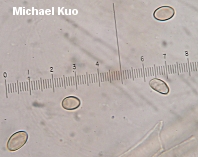Cap: 2-8 cm; conical to bell-shaped, becoming broadly bell-shaped, usually with a sharp and distinct central bump; dry; silky or finely hairy; straw yellow to yellowish or yellowish brown; the margin splitting and the surface becoming radially separated.
Gills: Attached to the stem but sometimes pulling away from it in age; close or crowded; whitish, becoming grayish and then brownish with maturity (sometimes developing a greenish cast).
Stem: 3-9 cm long; up to 1 cm thick; more or less equal, without a swollen base; dry; smooth or finely silky; sometimes twisted or grooved; whitish or pale yellowish.
Flesh: Whitish; insubstantial.
Hey, That Mushroom Smells Like . . .
"Disagreeable" was the preferred word in the era of Kauffman, when Victorian sensibilities still prevailed. The word "spermatic" began to appear with more and more frequency, however, as the 20th Century progressed, and now it is hegemonic. That's all well and good, I suppose--but the present widely accepted use of the term spermatic may underscore the fact that mycology is still an Old Boys network--and still reveals a Victorian hesitation. Yeah, that one's going to have to be explained.
The crux of my argument involves Russula xerampelina, the so-called "Shrimp Russula," which does not smell much like shrimp, to tell the truth, unless you are using "shrimp" as a synonym, a Victorian cover-up, for "vaginal." Why is it okay to call Inocybe rimosa spermatic, while heads would turn at a corresponding, genital-secretion-based description of Russula xerampelina? The answer is, because women mycologists are few and far between, and the Old Boys have not paused to imagine, for example, what must go through Inocybe expert Cathy Cripps's mind when she has to type "spermatic," or what a female graduate student in mycology must feel when she has to discuss the morphology of a species of Phallus with her male professor. If these good ole boys had to conjure up the olfactory memory of what is "vaginal" all the time, things might be different (then again, they might be worse). To be fair, since I brought up the parallel to Phallus, it should be pointed out that Amanita vaginata (as well as any mushroom that has a volva) forces male mycologists to address morphology with female genital terms--so maybe I should limit my argument to the odors.
And anyway, what the hell does sperm smell like? Does anyone know? And are we sure that, for example, one's diet doesn't influence the odor? I'm not just kidding around, because Inocybe sororia--to take one of many examples from the genus--is separated from the "spermatic" Inocybe rimosa primarily on the basis of its odor, which is universally proclaimed as the odor of "green corn." As Inocybe expert D. E. Stuntz wrote in 1947, "[t]he strong green corn odor of I. sororia is especially characteristic, and easily distinguished from the typically spermatic odor of I. fastigiata" (p. 46). It is? Stuntz clearly had an exceptional sniffer, especially in evidence in my personal favorite, his description of the odor of Inocybe picrosma:
[O]dor very characteristic, not strong, but very penetrating, spermatic for an instant when the context is first exposed, but immediately becoming quite complex, predominantly a mixture of raphanoid and resinous with a trace of acetic acid, having a very decided pungency which quickly produces a tingling sensation in the back of the throat" (1950, p. 105).
I hope to God I'm never forced to address this description when identifying an Inocybe, because I have trouble detecting the difference between, say, gasoline and lilacs. Throw in the fact that odors in Inocybe rimosa (the mushroom I'm supposed to be talking about) range from "none" to "mild" to "mealy" to "spermatic" to "strongly spermatic," depending on the author, and you begin to wonder whether there's a big, stinky, rotting mushroom in Denmark, and whether you might be better off moving somewhere else.
This website contains no information about the edibility or toxicity of mushrooms.
Cite this page as:
Kuo, M. (2005, February). Inocybe rimosa. Retrieved from the MushroomExpert.Com Web site: http://www.mushroomexpert.com/inocybe_rimosa.html


